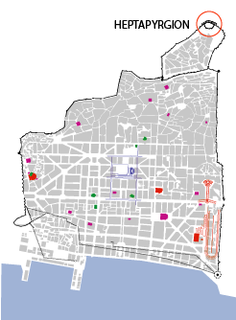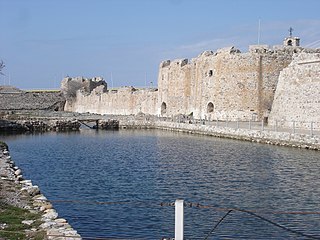 W
WThe Castle of Mytilene, also Fortress of Mytilene, is located in Mytilene on the Greek island of Lesbos, North Aegean. It is maintained in good condition and is one of the largest castles in the Mediterranean covering an area of 60 acres. The first castle on the site may have been erected during the time of Justinian I. The 6th-century castle may have been built on top of an already existent fortress. In the late Middle ages, the castle was the residence of Francesco I Gattilusio and his successors, especially the tower known today as the Queen's Tower. There is also strong evidence that the original acropolis on the site may have included a sanctuary to Demeter, Kore and Cybele.
 W
WThe Castle of Santa Maura is a fortress on the northeastern tip of the Greek island of Lefkada. The castle began as a small fortification in c. 1300 to control access to the island, before it was expanded to become a walled town and the island's capital by the early 15th century. The Ottoman Empire took possession in 1479, and a century later rebuilt and enlarged it, giving it largely its present shape. A sizeable town grew outside the castle walls by the 1670s.
 W
WThe Heptapyrgion, modern Eptapyrgio, also popularly known by its Ottoman Turkish name Yedi Kule, is a Byzantine and Ottoman-era fortress situated on the north-eastern corner of the Acropolis of Thessaloniki in Greece. Despite its name, which in both languages means "Fortress of Seven Towers", it features ten, and was probably named after the Yedikule Fortress in Constantinople. It served as the major redoubt of the city's acropolis, as well as the seat of its garrison commander in Ottoman times, until the late 19th century. It was then converted to a prison, which remained open until 1989. References to the infamous Yedi Kule prison abound in the Greek rebetika songs. Restoration and archaeological work began in the 1970s and continues to this day.
 W
WThe Izzeddin Fortress is an Ottoman fortress in Souda Bay, Crete, near the village of Kalami, best known for its role as a prison for political prisoners in 20th-century Greece.
 W
WKelefa is a castle and village in Mani, Laconia, Greece. It is part of the municipal unit of Oitylo.
 W
WThe fortress of New Navarino is an Ottoman fortification near Pylos, Greece. It is one of two castles guarding the strategic Bay of Pylos, on which it sits; New Navarino is located in the southern entrance of the bay, while the northern entrance is guarded by the 13th-century Old Navarino castle, built by the Crusaders of the Principality of Achaea. In juxtaposition with the latter, New Navarino is often known simply as Neokastro or Niokastro.
 W
WThe Rio Castle, historically known as the Castle of the Morea in opposition to its counterpart, the Castle of Rumelia at Antirrio, is located at the north tip of the Rio peninsula in Achaea, Greece, at the entrance of the Corinthian Gulf. The Rio-Antirio Bridge is located next to it, and the local ferry docks lie on either side. Today it is used for cultural purposes, especially concerts and is a tourist attraction.
 W
WThe so-called Wall of Haseki was a city wall built around Athens by its Ottoman governor, Hadji Ali Haseki, in 1778. Initially intended to protect the city from attacks by Ottoman Muslim Albanian warbands, it became an instrument of Haseki's tyrannical rule over the city.